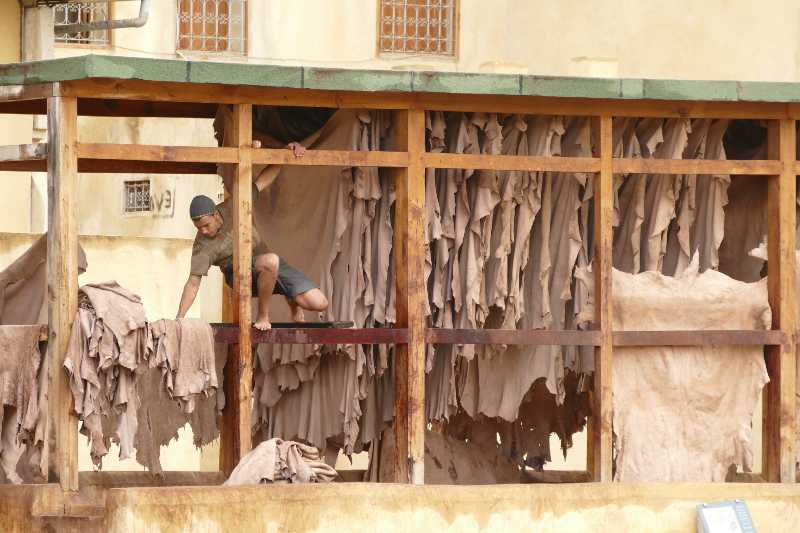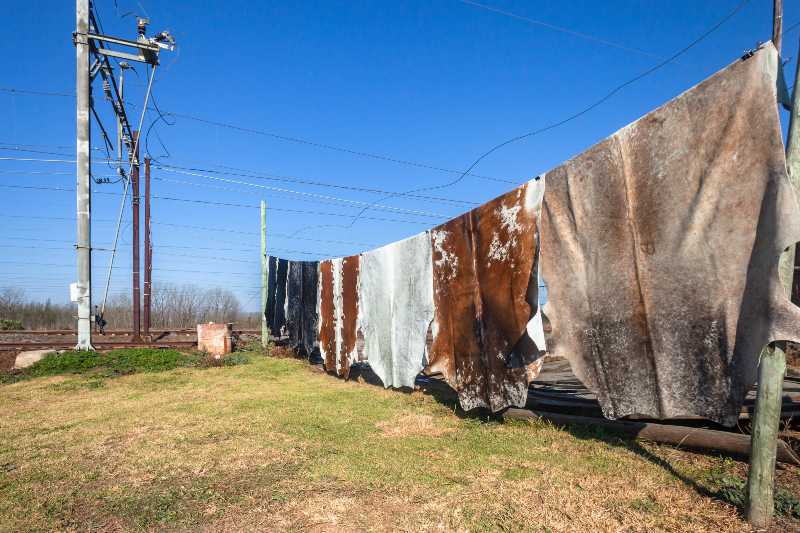Building
How to Make Rawhide

Surviving in the wild means making tools out of anything you find in your environment — even if it comes to using animal skin. Here’s a tutorial on how to make rawhide out of any animal hide you can find.
RELATED: Deer Hunting For Beginners: How To Get Started
How to Make Rawhide in 5 Steps
Click here to jump to the infographic

What You Need:
For De-Hairing and De-Fleshing:
- Animal hide of your choice
- 5-gallon pail
- Hydrated lime
- Stick for stirring
- Dull knife
- Water
- Fleshing beam
- Gloves (for safety)
For Neutralizing:
- 5-gallon pail
- Water
- Vinegar
- Baking soda
- Stir stick
For stretching and drying:
- Dull knife
- Twine
- Drying rack
Note: You can learn how to make rawhide out of any animal skin, we especially recommend using deer hide due to its size and relative flexibility compared to other types of animal hide.
1. Soak the Animal Hide in Hydrated Lime

To remove any animal hair from your hide, soak your hide in a large container filled with a very diluted mix of hydrated lime and water. It’s better to err on the side of being too diluted as too strong a solution can cause swelling and crack on the hide.
Use your stick to submerge and stir the hide in the bath and weigh it down with a rock to keep it submerged. Let it soak for at least a week and make sure to stir every day.
Your animal hide is ready when the hair easily comes out without pulling too hard.
2. Remove Hair and Membrane from the Animal Hide

Once clumps of hair easily fall out of the hide, remove it from the solution and place it on the fleshing beam. You can also use any flat surface if you don’t have a fleshing beam.
Use a dull knife to scrape the hair off of the hide. Be gentle when doing this so you don’t damage the grain layer.
Once you’ve removed all the animal hair, flip it over to the other side and gently get off as much of the membrane as possible. Make sure to do this gently to not damage the other side.
3. Rinse and Neutralize the Hide

After the de-fleshing and detailing process, rinse the hide in some clean water to clean it up. Next, mix 1/2 box of baking soda in 5 gallons of water and soak your hide in the solution.
Baking soda neutralizes the hydrated lime (an alkaline) and brings it to a neutral level.
Let the hide soak for a day, then drain the water off and soak again in a fresh baking soda and water solution until the hide no longer swells up. Then, prepare a solution of 1/3 cup of vinegar to 5 gallons of water and soak the hide in it for 30 minutes to overnight.
Finally, rinse the hide for the last time with some clean water to get rid of the stench.
RELATED: How To Skin A Deer Correctly
4. Stretch the Rawhide

Upon rinsing the hide, poke some holes around 1/2 in. big along the edge of your hide, space approximately 2-4 inches apart. Thread twine through each hole and tie it to the drying rack.
Don’t have a drying rack? You can tack it to an empty shed wall and it will work just as well.
Stretch the hide from one side to another, then repeat the process until you stretched from all sides. Don’t stretch too tightly, as the hide shrinks it size while it dries.
5. Let Dry

Let the hide hang on the rack until completely dry.
For a transparent end result, allow the hide to sag a bit while it dries. Otherwise, stretch the hide as tightly as you can without tearing it if you want an opaquer rawhide.
Here’s an infographic guide that you can use. Feel free to download, save and share it with your loved ones:

Know how to make rawhide mallets from Downeast Thunder Creations:
Knowing how to make rawhide gives you a tough material that turns malleable when soaked in water. In this form, you can sculpt rawhide into various items like knife sheaths, mallets, or even small water containers.
It’s the perfect way to use an entire animal to its full potential.
Have you made something out of rawhide? Share your creations in the comments section below!
Up Next:
- How To Practice For Bow Hunting
- Hunting: Learning to Hunt | Survival 101
- How to Keep Cats Away from Your House | 12 Simple Ways
Don’t forget to stay connected with us on Facebook, Twitter, Pinterest, and Instagram!
-

 Do It Yourself7 months ago
Do It Yourself7 months agoParacord Projects | 36 Cool Paracord Ideas For Your Paracord Survival Projects
-

 Do It Yourself9 months ago
Do It Yourself9 months agoHow To Make Paracord Survival Bracelets | DIY Survival Prepping
-

 Do It Yourself9 months ago
Do It Yourself9 months ago21 Home Remedies For Toothache Pain Relief
-

 Do It Yourself10 months ago
Do It Yourself10 months agoSurvival DIY: How To Melt Aluminum Cans For Casting
-

 Exports8 months ago
Exports8 months agoAre Switchblades Legal? Knife Laws By State

